Hole in the Clouds
Jan 8, 2014
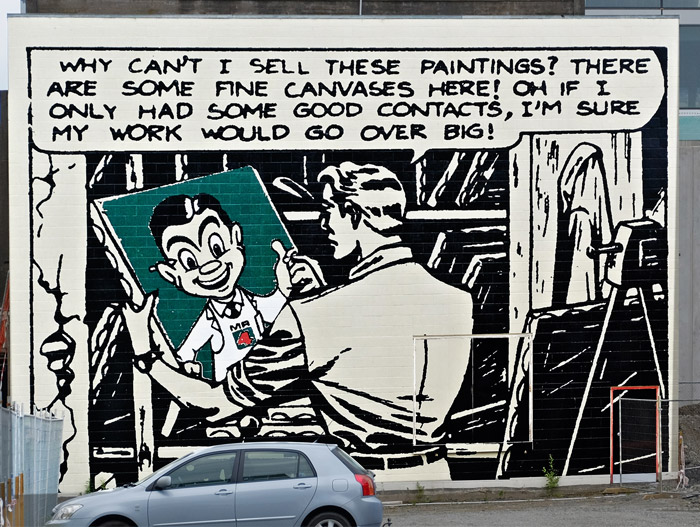 The little guy here in the white apron, with a pencil behind his ear–that's Mr. 4, the grocer-mascot of New Zealand's ubiquitous Four Square chain of supermarkets.
The little guy here in the white apron, with a pencil behind his ear–that's Mr. 4, the grocer-mascot of New Zealand's ubiquitous Four Square chain of supermarkets.
The mural featuring Mr. 4 covers a side wall of the art museum in Christchurch. The museum is closed at the moment and has been for a couple of years. All the artwork currently on exhibit is out in the streets of the city, like this piece.
Perhaps you are wondering why in the picture below there's a crane on top of the museum? Hold that thought; we'll get to it soon.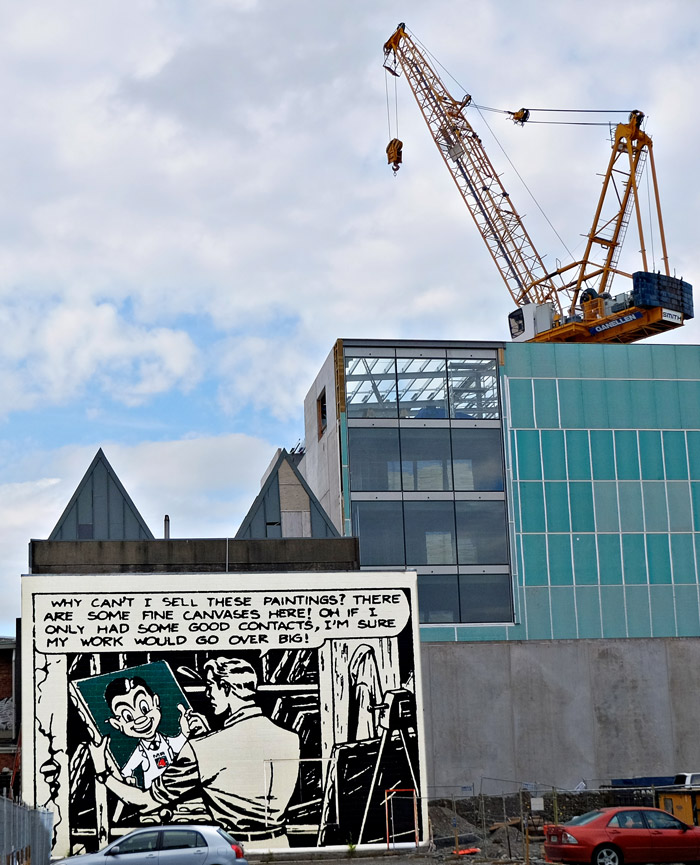
museum
New Zealand
art
streetscape
earthquake
mural
crane
grocery store
logo
Christchurch
(Image credit: Little Fuji)
Jan 11, 2014
 On 22 February 2012, white-painted chairs were set up alongside busy Cashel Street in Christchurch, New Zealand, each one different from the others, all of them empty. They covered a freshly sodded swath of a freshly vacant lot, where Baptists used to go to church before an 18-second-long earthquake took out the church, along with about 8,000 other buildings in town.
On 22 February 2012, white-painted chairs were set up alongside busy Cashel Street in Christchurch, New Zealand, each one different from the others, all of them empty. They covered a freshly sodded swath of a freshly vacant lot, where Baptists used to go to church before an 18-second-long earthquake took out the church, along with about 8,000 other buildings in town.
The chairs memorialize the 185 residents of Christchurch who died in the quake. One hundred fifteen of them were in a six-story office building that day across the street from what is now the memorial; in 18 seconds, the building pancaked and caught fire.
The chairs appeared one year to the day after the quake. Like so much else in the city's recovery from the disaster, the chair memorial, designed by Peter Majendie, was planned as transitional and very temporary, to remain on display for a week.
It's still there. Believe it or not, vandals steal chairs from the memorial every now and then, but so far at least, they've been replaced.
This transition stuff can be tough. New Zealand's latest census figures came out last month, revealing that more than 40,000 people have left Christchurch since the earthquake. The city is no longer the country's second largest. The official estimate now is that recovery will take twenty years, minimum.
Here is how people in Christchurch described the quake to us: the earth heaved straight upward, we were told, and then plummeted, slamming back down. Eyewitnesses reported seeing people literally thrown up into the air.
The next several posts will look at what's going on there nowadays, a little less than three years later.
New Zealand
streetscape
earthquake
chairs
memorial
Christchurch
(Image credit: Little Fuji)
Jan 12, 2014
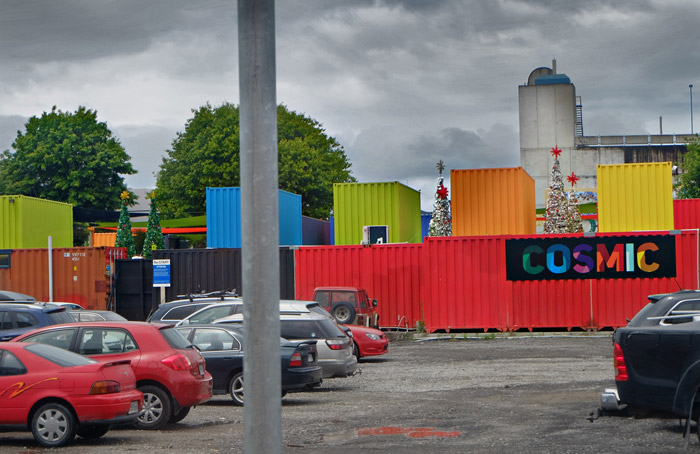 The earthquake that devastated Christchurch wasn't "the big one" there; it was just an aftershock, one of more than 8,000 aftershocks of magnitude 3.0 or more during the months following a massive magnitude 7.1 quake in September 2010.
The earthquake that devastated Christchurch wasn't "the big one" there; it was just an aftershock, one of more than 8,000 aftershocks of magnitude 3.0 or more during the months following a massive magnitude 7.1 quake in September 2010.
The big one caused terrible damage to the city and its suburbs, but mostly to older buildings; most modern construction survived more or less unscathed, thanks to New Zealand's strict seismic building codes. And no one died that day.
Although all of New Zealand is at elevated risk of earthquakes, Christchurch was not considered at especially high risk. The 2010 quake came pretty much out of the blue, rupturing a fault west of town that was hitherto unknown to geologists.
The aftershocks that followed were unnerving, to put it mildly, shaking the city day after day, often many times a day. They threatened to destabilize already damaged buildings, and they discouraged any and all efforts to start the rebuilding process.
The February 2011 aftershock that finally flattened Christchurch was different from the others in several ways. Although its magnitude was measured at just 6.3, much weaker than the original quake, its epicenter was very close to the center of town, just 10 km east of downtown. It caused movement along a shallow fault, only 5 km below city streets. And most devastating of all, this movement was largely up-and-down in nature, as opposed to the sideways shaking characteristic of the vast majority of quakes around the world.
Ground movement during the February 2011 quake was recorded at numerous seismic stations around town. Acceleration reached an unheard-of 2.2 times the force of gravity, a violent vertical wrenching that even strict seismic building codes had not contemplated.
After it hit, city officials had to cordon off the downtown area–the Red Zone–with its perimeter patrolled by armed soldiers. Entire residential neighborhoods were emptied out and slated for demolition; some were deemed unsuitable for rehabitation ever again. At least 1,000 commercial buildings and 7,000 houses were completely destroyed. No modern city has ever suffered more devastation from any earthquake.
The aftershocks continued, but now they were only one of many factors slowing or stalling redevelopment. First, all the ruined buildings had to come down, and all their rubble had to be carted away. Heavy equipment and demolition teams soon arrived in Christchurch from as far away as Ireland, but they couldn't work fast; even if financing and permitting went smoothly, which they never did, extreme caution was needed at the work sites to protect weakened structures nearby.
The vacant lots that gradually replaced rubble throughout the city often became parking lots. In fact, parking is easy now even in the heart of downtown. Not that there's much reason for many people to drive downtown these days–the old shopping mall is gone, there are only a handful of restaurants functioning, the theaters and office buildings and almost all the hotels are gone. City Hall and most other government buildings are emptied out.
Given all that newly empty land in the city center, it was inevitable that people would come up with ideas for temporary uses–popup structures built with readily available materials to bring back a little life to downtown Christchurch.
The photo above shows the Re:Start Mall, as seen from a parking lot in back; the stores and cafes that have sprung up on the site of a ruined shopping center are all made out of shipping containers.
Below, shoppers and tourists visit the new mall. And below that is the Pallet Pavilion, a new downtown cafe and performance space built out of wooden pallets, with plastic crates for seating.
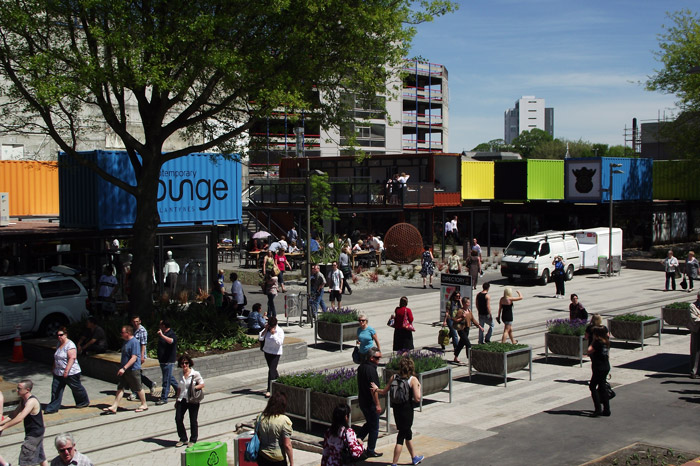
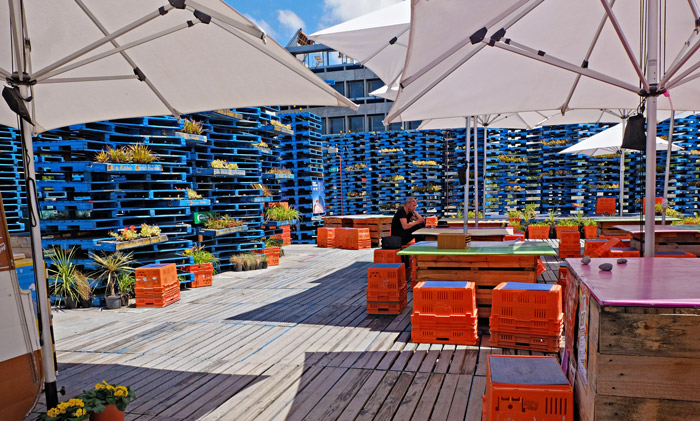
earthquake
Christchurch
containers
pallets
Jan 13, 2014
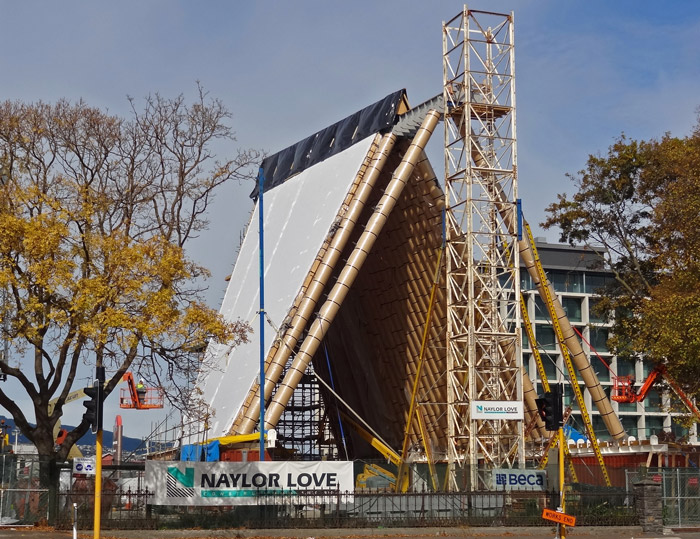 Before the earthquake, Christchurch had two cathedrals: the Gothic-style Anglican Christ Church Cathedral on the city's central square and the Italianate Roman Catholic Cathedral of the Blessed Sacrament nearby. Both were ruined in the quake.
Before the earthquake, Christchurch had two cathedrals: the Gothic-style Anglican Christ Church Cathedral on the city's central square and the Italianate Roman Catholic Cathedral of the Blessed Sacrament nearby. Both were ruined in the quake.
In the aftermath of the quake, both the Anglican and the Catholic establishments became notably secretive about their plans for rebuilding and/or repair. The Anglicans were sued over insurance payouts and municipal maintenance funds. The Catholics spirited away all the decorative elements and artwork from their cathedral and hid everything at a still-undisclosed location.
Both cathedrals sit in ruins today, not yet demolished, propped up by flying buttresses made of steel I-beams and stacks of shipping containers filled with concrete.
Meanwhile, the Anglicans have built a new cathedral, allegedly for temporary use, on the site of a nearby church that was also destroyed in the earthquake. The new cathedral, with its cardboard-tube roof beams, was designed pro bono by Japanese architect Shigeru Ban, who has achieved worldwide acclaim for his post-disaster structures, many of which are built from inexpensive and readily available materials, including paper, cardboard, plastic crates, and shipping containers.
The new Cardboard Cathedral opened last August. It can hold 700 people for church services and also serves as public meeting space.

New Zealand
architecture
earthquake
church
Christchurch
Shigeru Ban
Jan 14, 2014
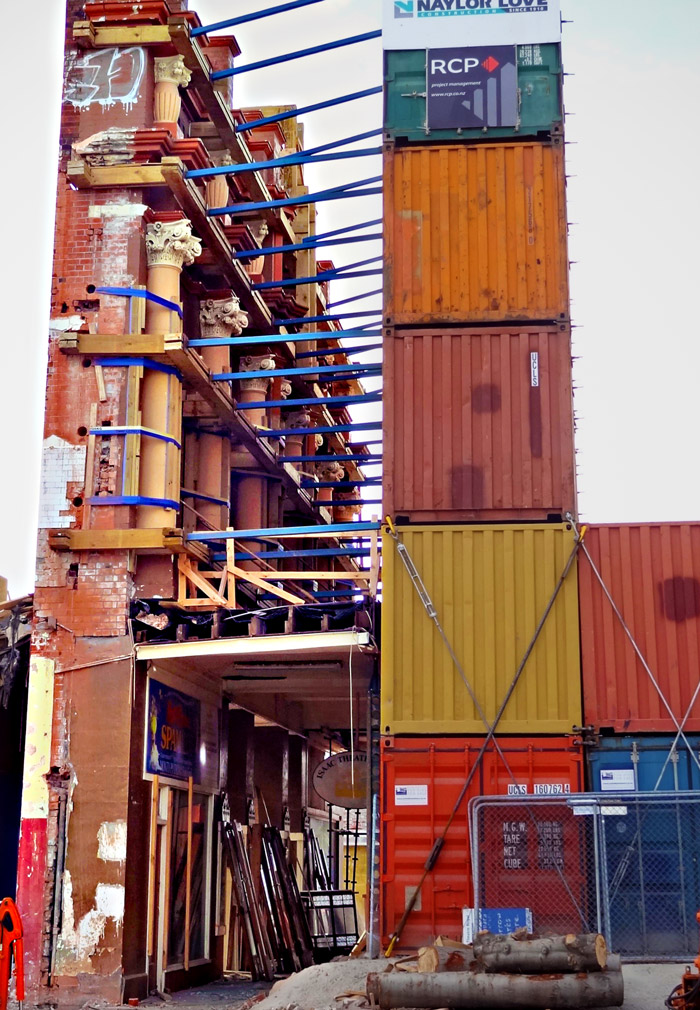
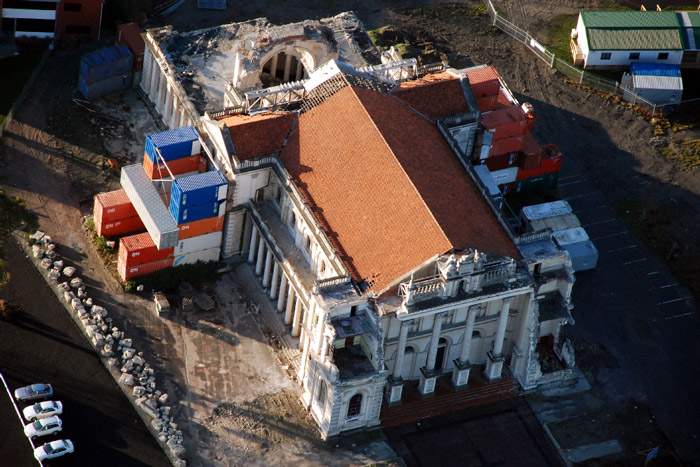
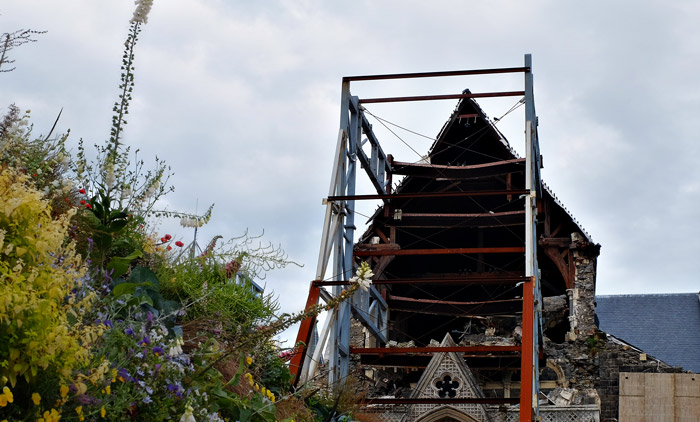

New Zealand
cityscape
streetscape
earthquake
ruins
Christchurch
Apr 21, 2015
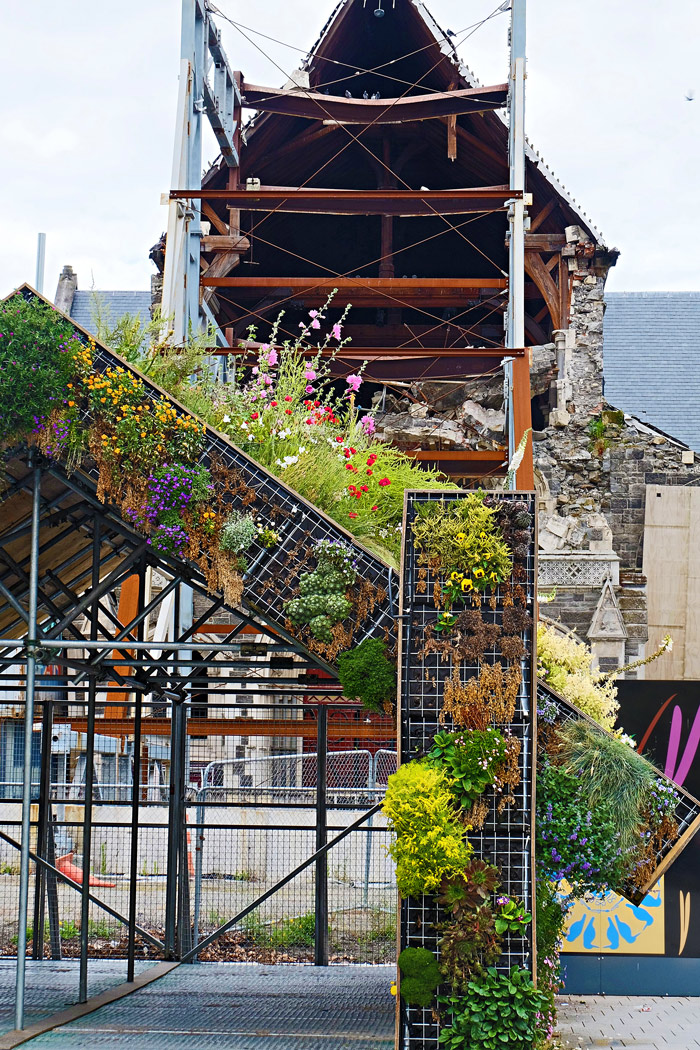 The year of earthquakes in Christchurch, New Zealand, back in 2010 and 2011, left devastation that was still immediately obvious and widespread when we visited in December 2013.
The year of earthquakes in Christchurch, New Zealand, back in 2010 and 2011, left devastation that was still immediately obvious and widespread when we visited in December 2013.
Many ruined buildings were still propped up then, still awaiting demolition. Some repairs had been begun, some new construction was under way, but the city's main shopping district had been displaced into a new popup mall made out of shipping containers.
Christ Church Cathedral, shown here, once dominated the city's central square. As of this writing, no decision has yet been announced concerning whether to repair or replace or simply demolish what's left of the structure. The new popup Cardboard Cathedral a few blocks away has not officially been designated as a replacement.
New Zealand
cathedral
earthquake
ruins
Christchurch
Christ Church Cathedral
(Image credit: Little Fuji)
 The little guy here in the white apron, with a pencil behind his ear–that's Mr. 4, the grocer-mascot of New Zealand's ubiquitous Four Square chain of supermarkets.
The little guy here in the white apron, with a pencil behind his ear–that's Mr. 4, the grocer-mascot of New Zealand's ubiquitous Four Square chain of supermarkets.










